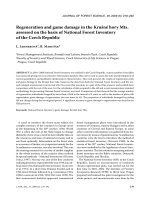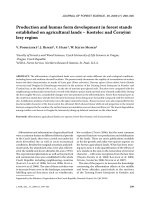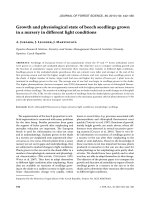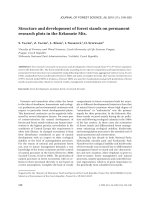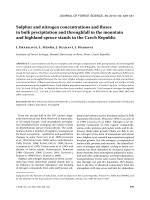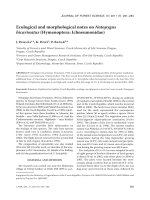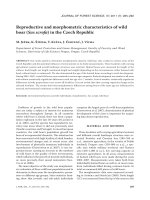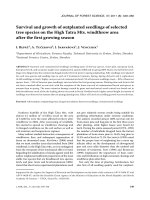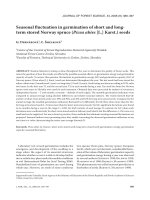Báo cáo lâm nghiệp: "Electrophysiological and behavioral responses of Dendroctonus valens to non-host volatiles" pdf
Bạn đang xem bản rút gọn của tài liệu. Xem và tải ngay bản đầy đủ của tài liệu tại đây (379.41 KB, 7 trang )
Ann. For. Sci. 64 (2007) 267–273 267
c
INRA, EDP Sciences, 2007
DOI: 10.1051/forest:2007004
Original article
Electrophysiological and behavioral responses of Dendroctonus valens
to non-host volatiles
Long-wa Z
a,b
, Nancy E. G
c
, Jiang-hua S
a
*
a
State Key Laboratory of Integrated Management of Pest Insects and Rodents, Institute of Zoology, the Chinese Academy of Sciences,
Beijing 100080, PR China
b
Graduate School of Chinese Academy of Science, Beijing 100080, PR China
c
USDA Forest Service, Pacific Southwest Research Station, Berkeley, CA 94701, USA
(Received 8 May 2006; accepted 25 August 2006 )
Abstract – Non-host volatiles (NHVs) that are often reported as being disruptive to coniferophagous bark beetles were tested for both electrophysiolog-
ical and behavioral effects on the red turpentine beetle, Dendroctonus valens LeConte (Coleoptera: Curculionidae: Scolytinae), which was accidentally
introduced into China in the mid-1980’s. All NHVs tested elicited dose-dependent antennal responses by D. valens. In Y-tube olfactometer trials, D.
valens were repelled by NHVs tested. When NHVs were added to a kairomone blend, responses of D. valens were significantly inhibited. Further field
trapping experiments showed that attraction of D. val e ns to kairomone baited traps was reduced by all individual NHVs, with reductions ranging from
26.3 to 70%. 1-Octen-3-ol, (Z)-3-hexen-1-ol, and (E)-2-hexen-1-ol were the three most effective NHVs, significantly reducing D. valens to kairomone-
baited traps by 69.5, 68.3 and 66.0%, respectively. In the development and implementation of a semiochemical-based management programme for D.
valens, NHVs may have considerable potential for disrupting the beetle’s ability to locate suitable hosts.
non-host volatiles / red turpentine beetle / electroantennograms / olfactory response / field trapping
Résumé – Réponses électrophysiologiques et comportementales de Dendroctonus valens à des composés volatils non-hôtes. Au cours de cette
étude, on a testé les effets de composés volatils non hôtes, souvent considérés dans la littérature comme pouvant affecter la reconnaissance de l’hôte
chez les scolytes des conifères, sur les réponses électro-physiologiques et le comportement du scolyte Dendroctonus valens LeConte (Coleoptera :
Curculionidae : Scolytinae), espèce introduite accidentellement en Chine depuis le milieu des années 1980. Tous les composés testés ont généré
des réponses antennaires, dépendant de la dose. Dans des tests en olfactomètre en Y, on a observé une plus ou moins grande répulsion à certains
composés. En particulier, les réponses au 1-octen-3-ol, au 1-hexanol, à l’ hexanal et au 3-octanol ont été très faibles. Des expérimentations de terrain
ont ensuite montré que l’attraction sur D. valens de pièges appâtés en kairomone a été réduite par l’adjonction de chacun des composés non- hôtes, cette
réduction variant de 26.3 à 70 %. Parmi ces composés, le 1-octen-3-ol, le (Z)-3-hexen-1-ol et le (E)-2-hexen-1-ol ont été les plus efficaces, engendrant
respectivement une réduction des captures de 69.5, 68.3 et 66.0 %. L’utilisation de composés volatils non- hôtes pour induire une confusion dans le
choix de l’hôte représente donc un potentiel considérable pour le développement d’un programme de gestion des populations de D. valens,basésur
l’utilisation de produits semio-chimiques.
scolyte / électro-antennogramme / réponse olfactive / composés volatiles non-hôtes / piégeages de terrain
1. INTRODUCTION
The red turpentine beetle, Dendroctonus valens LeConte
(Coleoptera: Curculionidae: Scolytinae), an exotic pest in
China, was first reported from China in 1983 in Shanxi
Province [9, 26]. This exotic beetle was presumed to have
been introduced via imported, unprocessed Pinus ponderosa
Douglas ex P. and C. Lawson logs sent to Shanxi from the
west coast of the United States [26]. D. valens is normally a
non-aggressive pest of diseased and wounded conifers, princi-
pally in the genus Pinus (L.). In North America, D. valens is
geographically widespread, ranging from Canada in the north
to Central America in the south, and extending the breadth of
* Corresponding author:
the continent in the northern part of its range [7]. It has a wide
host range, attacking all pines within its geographic range [5].
Despite its abundance and wide distribution, outbreaks of D.
valens have generally not been extensive or severe in North
America, and its impact has been relatively minor [18]. In re-
cent years, however, there have been outbreaks related to me-
chanical injury to tree roots [15, 19].
In contrast with its role as a secondary pest in North Amer-
ica, D. valens has become a very destructive pest to its new
host species Pinus tabuliformis Carrière in China. Since its
first large outbreak in 1999 in Shanxi Province, D. valens
spread rapidly to the adjacent provinces of Hebei, Henan and
Shaanxi, and has infested over 500 000 ha of Chinese pine
stands, primarily those over 30 years old, killing more than
6 million trees to date [9, 10]. It is currently the second most
Article published by EDP Sciences and available at or />268 L W. Zhang et al.
damaging forest pest in the country [10]. Considering the wide
host range of D. valens in North America [5], the majority of
Chinese pines are probably at risk. Moreover, P. tabuliformis,
the principal host of D. valens in China, is extremely impor-
tant for reforestation and is widely planted across a large por-
tion of the country [9]. The potential damage from D. valens
is therefore enormous, and effective measures for monitoring
and controlling D. valens are desperately needed [9, 19].
D. valens is known to use host odors or kairomones to lo-
cate and select its preferred hosts [8, 11, 23]. Hobson et al.
[8] showed that the primary attractants in central California
were (-)-β-pinene and (+)-α-pinene, with 3-carene as a minor
component of the attractive blend. Sun et al. [20] showed that
3-carene was the dominant attractant for Chinese populations
of D. valens, and (-)-β-pinene and (+)-α-pinene were behav-
iorally neutral, or nearly so.
Recent electrophysiological and behavioral studies clearly
indicate that conifer bark beetles are not only able to recog-
nize, but also to avoid, non-host habitats or trees by olfaction.
Non-host volatiles (NHVs) may represent a key semiochem-
ical signal in the discrimination between host and non-host
species by conifer-infesting bark beetles [3]. NHVs comprise
both green leaf volatiles (GLVs) and non-host bark volatiles.
Green leaf volatiles are aliphatic 6-carbon primary alcohols,
aldehydes and acetates that are ubiquitous in broad-leaf trees
and herbaceous plants [21, 22], for example, 1-hexanol, (Z)-
3-hexen-1-ol, (E)-2-hexen-1-ol and hexanal. Non-host bark
volatiles, including 3-octanol, 1-octen-3-ol, benzyl alcohol
and trans-conophthorin, have also been found in the bark of
several non-host angiosperm trees [29].
In this study, we tested several non-host volatiles that are
often reported in the literature as being disruptive to conifer-
attacking scolytids, using electoantennogram (EAG) assays
and behavioral tests both in the laboratory and field. The goals
of this study were: (1) to determine by EAG if the non-host
volatiles are perceived by D. valens antennae; (2) to evaluate
the behavioral response in a Y-tube olfactometer to the anten-
nally active NHVs; (3) to find the potential disruptants for D.
valens in a field trapping experiment in China.
2. MATERIALS AND METHODS
2.1. Insects
D. valens were collected the from a P. tabuliformis plantation
at Tunlanchuan Forest Station, west of the city of Gujiao, Shanxi
Province, in 2004. Adults were sexed and maintained in an incubator
at 25
◦
C and 55% RH, under a light-dark cycle of 14L:10D before
being used in EAG and bioassay experiments.
2.2. Chemicals
NHVs used in electroantennogram tests and Y-tube olfactome-
ter trials were obtained from Acros Organics (Geel, Belgium), and
their chemical purities were as follows: 1-hexanol, 98%; (Z)-3-hexen-
1-ol, 98%; (E)-2-hexen-1-ol, 96%; 3-octanol, > 99%; 1-octen-3-ol,
98%; hexanal, 96%; and benzyl alcohol, 99%. The components of
the kairomone blend, (+)-α-pinene, (-)-β-pinene, and (+)-3-carene,
were obtained from Aldrich Chemical Co. (Milwaukee, Wisconsin).
Their chemical purities were 99%, 98%, and 97%, respectively.
2.3. Electroantennogram (EAG) response
The EAG technique was modified from the method used by White
and Hobson [24] as follows: antennae were excised from the heads
of D. valens, then mounted between two glass micropipettes filled
with insect Kaissling saline. The recording electrode was carefully in-
serted into the distal edge of the antennal club and the indifferent elec-
trode into the basal scape of the same antenna. Micro-electrodes were
held with micromanipulators (style MP-15, Syntech, Hilversum,The
Netherlands) and connected to a high input impedance AC/DC micro-
amplifier (model Un-06, Syntech) via Ag /AgCl junctions.
Each 10 µL dose of test material was applied to a filter paper strip
(5×50 mm) and the solvent allowed to evaporate before use. The filter
paper was then inserted into a Pasteur pipette. The tip of the pipette
containing the sample dosage was positioned 1 cm upwind from the
antennal preparation. Odor stimuli were delivered from the pipettes as
1.0-s pulses into a continuous airstream (124 mL/min). The EAG sig-
nal was amplified by a DC/AC amplifier. Amplified EAG responses
were digitized using a Nelson 900 Series Interface and displayed and
processed on a PC using Spike software (Syntech).
First, a single dose (1 µg/µL) in hexane of the seven compounds
was presented. Later, a log dilution series was made and tested for
seven compounds, at doses of 0.0001, 0.001, 0.01, 0.1, 1, 10, and
100 µg/µL, to better understand the response characteristics of D.
valens. Seven compounds were presented to the antenna randomly,
in order of concentration, with the lowest dose first. An interval of at
least 1 min between puffs was utilized to ensure complete antennal
recovery. At least 5 females and 5 males were tested with each com-
pound. A hexane-only control and standard solution ((+)-3-carene at
1µg/µL in hexane) were presented before and after each test material.
(+)-3-Carene has been shown to be the component of the kairomone
blend which elicits the strongest electrophysiological and behavioral
responses by D. valens in China [20].
2.4. Y-tube olfactometer trials
Bioassays were conducted in a glass Y-tube olfactometer (16 mm
diam, main tube 20 cm long, arm length 25 cm), with a 120
◦
inside
angle. Incoming air was filtered through activated charcoal and hu-
midified with doubly distilled, deionized water. The filtered air was
split between two, 2-1 holding chambers [2]; one chamber, holding
the kairomone blend (1:1:1 ratio of (+)-α-pinene:(-)-β-pinene:(+)-
3-carene), served as a positive control and the other chamber held
the kairomone blend plus NHVs. The kairomone blend (100 µg) and
NHVs (100 µg), in 10 µL of hexane, were applied to a filter paper
strip (5 × 50 mm). The solvent was allowed to evaporate for 20 s,
then the filter paper was placed into the chambers. From each holding
chamber, the air passed into the respective arms of the Y tube. Air-
flow through the system was maintained at 200 mL/minbyaninline
flowmeter. A prior smoke test demonstrated laminar airflow in both
arms and throughout the olfactometer. To eliminate visual cues, the
Y-tube setup was surrounded by a 80 × 60-cm black fabric enclosure.
All experiments were conducted in the daytime between 08:00 AM
and 17:00 PM. Temperature and RH in the olfactometer were main-
tained at 25
◦
and 70%, respectively.
Interruption of Dendroctonus valens by NHVs 269
Tab le I. Description of semiochemicals employed in trapping exper-
iments for Dendroctonus valens, Shanxi Province, 2004.
a
Chemicals Dispensers
b
Release rate mg/d
Kairomone blend 15-mL Bottle 110.0
1-hexanol Bubble cap 570 mg 5.2
(Z)-3-hexen-1-ol Bubble cap 700 µL 25.6
(E)-2-hexen-1-ol Bubble cap 16.0
3-octanol Bubble cap 56.9
1-octen-3-ol Bubble cap 29.3
Hexanal Bubble cap 700 µL 29.2
Benzyl alcohol Bubble cap 10.0
a
The non-host volatiles (NHVs) used in field trials were ob-
tained from Phero tech, while chemicals of the kairomone blend:
[(+)-α-pinene: (-)-β-pinene: (+)-3-carene (1:1:1)] were obtained
from Aldrich Chemical Co. (Milwaukee, Wisconsin); their chemical
purities were: (-)-β-pinene, 99%, (+)-α-pinene, 98%, (+)-3-carene,
97%, respectively.
b
Release rates for field trials determined under field conditions,
(mean temperature > 27
◦
)C. Note: the release rates of benzyl alcohol
and (E)-2-hexen-1-ol were determined by Phero tech at 30
◦
.
Approximately 30 min before trials were initiated, adult D. valens
were introduced to a separate holding container, so they would not be
exposed to test odors before their release. At the beginning of each
trial, a beetle was released at the downwind end of the Y tube. It was
given 10 min to respond to the treatment, and a choice for the left or
right arm of the olfactometer was noted when the beetle went 5 cm
past the Y junction. The beetle was scored as being attracted or being
repelled by the experimental odor blend. The arms of the olfactometer
were exchanged after each replicate.
2.5. Field trials
The field trapping experiments were conducted in 2004 in a 35-
year-old plantation of P. tabuliformis in the Tunlanchuan Forest Sta-
tion (N 37
◦
48
, E 111
◦
44
average elevation 1400 m), west of the
city of Gujiao, Shanxi Province. For the previous two years, stumps
infested with D. valens had been treated with insecticide fumigation
and sealed in plastic to prevent beetle emergence. Nevertheless, about
20% of standing trees were currently suffering D. valens attacks at
the time of the study. All experiments employed 8-unit multiple fun-
nel traps laid out between rows of P. tabuliformis. In order to suspend
traps, 90 trees were randomly selected from all trees within the stand,
with a minimum spacing of at least 50 m between selected trees. A
trap was then suspended from each of those trees, with the collec-
tion cups ca. 20 cm above ground level. Traps were suspended at
that height because that is the level at which D. valens attacks trees.
A plastic insecticidal strip saturated with 2,2-dichlorovinyl dimethyl
phosphate was put in each collection cup as a killing agent. The ex-
periment was set up on 21 May 2004, and beetles were collected from
traps every 5–7 days until 20 July 2004. A total of 9 treatments with
10 replicates each were applied in the study, with a totally random-
ized design.
The description of semiochemicals employed in trapping experi-
ments for D. valens is presented in Table I. These seven NHVs were
chosen because they are often reported in the literature as being dis-
ruptive to closely related conifer-attacking scolytids. In our experi-
ment, the kairomone blend consisted of a 1:1:1 blend of three host
monoterpenes: (+)-α-pinene, (-)-β-pinene, and (+)-3-carene, which
has been used extensively over the last decade for monitoring of D.
valens populations in North America [13], and was thus intended as
a positive control against which the bioactivity of NHV treatments
added to the kairomone blend could be assessed. Unbaited control
traps served as negative control (blank) treatments. All D. valens
adults captured in each trap on each date were counted. Voucher spec-
imens were deposited in the Institute of Zoology, Chinese Academy
of Sciences, Beijing.
2.6. Statistical Analysis
The net EAGs were calculated by subtracting the mean responses
to the controls introduced before and after the sample. EAG data were
standardized by calculating the percentages of the net EAGs relative
to the standard solution. The difference of antennal responses by sex
to NHVs at seven doses were analyzed using Mann-Whitney tests.
In Y-tube olfactometer trials, Chi-square tests were used to exam-
ine differences in response of D. valens to NHVs by sex. The null
hypothesis that D. valens showed no preference for either olfactome-
ter arm (a response equal to 50:50) was analyzed with a Binomial
test. The numbers of insects captured were transformed by log (x + 1)
to satisfy assumptions of normality and homoscedasticity. The trans-
formed data were analyzed by analysis of variance (ANOVA) fol-
lowed by the Ryan-Einot-Gabriel-Welsch range test. All data were
analyzed with the program for Windows 11.0 (SPSS Inc., 2001).
3. RESULTS
3.1. Electroantennogram (EAG) response of D. valens
to non-host volatiles (NHVs)
First, the antennal responses of D. valens to seven NHVs at
a single dose (10 µg) of were recorded. Measurable antennal
responses were elicited to all compounds tested. Subsequently,
dose-response of EAG response of D. valen s to dilutions of
NHVs were tested. There were no significant differences in
EAG responses to specific NHVs doses between the sexes,
except to 1-octen-3-ol at dose of 0.1 µg(P = 0.031), using
Mann-Whitney tests.
D. valens antennae displayed a similar shape of dose-
response curves for benzyl alcohol, 1-octen-3-ol, (Z)-3-hexen-
1-ol, and 3-octanol (Fig. 1). With rising stimulus dose, the
EAG amplitudes increased to a maximum level where they
either reached a plateau or dropped off slightly. Most of the
NHVs elicited the biggest EAG response at a stimulus of 10 µg
or 100 µg, whereas the dose-response curves showed no evi-
dence of saturation to (E)-2-hexen-1-ol, 1-hexanol and hex-
anal even at the highest dose tested.
In whole, both sexes showed a similar EAG dose-curves,
whereas there were also showed some differences between D.
valens sexes to tested NHVs. For instance in the case of (E)-2-
hexen-1-ol and 1-hexanol there is no increase in response from
10 µg in females whereas the amplitude still grows in males.
For female EAG response to hexanal showed a clear dose-
dependent effect, whereas in male responses plateau around
40 whatever the dose.
270 L W. Zhang et al.
3.2. Y-tube behavioral bioassay
The walking behavioral responses to the tested compounds
were similar for females and males of D. valens by Chi-square
tests (1-hexanol, χ
2
= 1.580, P = 0.209; (Z)-3-hexen-1-
ol, χ
2
= 0.418, P = 0.518; (E)-2-hexen-1-ol, χ
2
= 0.170,
P = 0.680; hexanal, χ
2
= 0.170, P = 0.680; 3-octanol,
χ
2
= 1.360, P = 0.244; 1-octen-3-ol, χ
2
= 0.257, P = 0.612;
benzyl alcohol, χ
2
= 0.224, P = 0.636), so data for males and
females were pooled before further analysis. Several NHVs
tested all reduced attraction of D. valens when added to the
kairomone (Fig. 2).
3.3. Field trapping trials
A total of 3816 D. valens adults were captured in the
field trapping experiments in 2004. All of the individual
NHVs caused reductions (ranging from 26.3 to 69.5%) in trap
catches, compared with the kairomone blend alone.
One-way ANOVA showed that traps releasing three NHVs
(1-octen-3-ol, with reduction of 69.5%, (Z)-3-hexen-1-ol, with
reduction of 68.3%, and (E)-2-hexen-1-ol, with reduction of
66.0%), all significantly disrupted the response of D. valens
to the kairomone blend (F
8;70
= 19.14, P < 0.01) (Fig. 3).
Catches of traps releasing four other NHVs (hexanal, 1-
hexanol, 3-octanol and benzyl alcohol) were somewhat lower
than traps releasing the kairomone blend, with reductions
of 52.9, 47.7, 35.2, and 26.3%, respectively, but not signifi-
cantly so.
4. DISCUSSION
In identifying the volatiles that insects use to locate suit-
able host plants, electrophysiological recordings of olfactory
responses to plant volatiles may give important information.
Antennal responses to non-host leaf and bark volatiles have
been found in more than 10 bark beetle species [29]. Previous
research focused primarily on the use of host monoterpenes
(kairomones) by D. valens to locate and select its preferred
hosts. D. valens should employ a generalist type of olfactory
receptor neuron on its antennae, which respond to a variety
of host monoterpenes. Our results show that NHVs tested in
this research elicit antennal responses in D. valens. Moreover,
D. valens responded in an obviously dose–dependent fashion
to all compounds tested. This result is consistent with previ-
ous studies showing that there are no significant differences
between sexes in antennal responses to NHVs [29]. But the
EAG dose-curves displayed slightly differences between sexes
of D. valens to tested, especially hexanal and (E)-2-hexen-1-
ol. Zhang et al. [31] suggested that there is a specialized type
of NHV-sensitive receptor neuron on scolytid antennae, based
on results from Europe and Canada. We hypothesize that D.
valens have also such an NHV-sensitive receptor neuron. Such
electrophysiological speculation can not be supported or re-
jected from EAG data, however, until individual cells (both
receptor and antennal lobe neurons) are tested by using the
single-cell recording technique [28]. Further studies on di-
versity and specificity of olfactory receptor neurons respond-
ing to host and non-host volatiles will be helpful to answer
this question and to understand the host-finding mechanism of
D. valens.
The laboratory bioassays experiments demonstrated that
the tested NHVs, individually, displayed more or less repel-
lent effect to D. valens. The laboratory bioassays confirmed
electrophysiological responses and the field trapping exper-
iments gave further evidence that NHVs interrupt the host
selection behavior of D. valens. The result was consistent
with previous studies that antennally active NHVs disrupt the
response of many conifer-infesting scolytids to the positive
(pheromone/kairomone) signals [29].
The life cycle of D. valens in its Chinese hosts appears to
be more cryptic than in its native hosts, with deeper coloniza-
tion of roots. Insecticidal and fumigation measures to control
D. valens have had only limited success in China [9, 10].
For these reasons, current bark beetle management focuses
on exploiting semiochemical signals that interrupt host selec-
tion by bark beetles [3, 16]. It would be adaptive for conifer-
inhabiting bark beetles to recognize and avoid general volatile
compounds that are commonly found in a wide variety of non-
host deciduous and herbaceous volatiles rather than recogniz-
ing precise tree-specific volatiles for each non-host species [4].
In turn, we can make use of these properties to develop new
management tools for controlling bark beetles. Overall, the re-
sults of our field trapping experiment show that 1-octen-3-ol,
(Z)-3-hexen-1-ol, and (E)-2-hexen-1-ol were the three most
effective NHVs in disrupting the location and selection of the
preferred host of D. valens in China. Other reports showed
similar disruption by alcohols, with the two most effective be-
ing (Z)-3-hexen-1-ol and (E)-2-hexen-1-ol [25]. 1-Octen-3-ol
was not only identified in the bark volatiles of European birch
and aspen [30, 31] but also identified in females of D. pon-
derosae, D. rufipennis, and D. pseudotsugae [14]. Further field
tests found that 1-octen-3-ol was repellent to all three Den-
droctonus spp. (D. ponderosae, D. rufipennis, and D. pseu-
dotsugae), and 1-octen-3-ol can be potentially be classified as
an antiaggregation pheromone, or serve as a kairomone, indi-
cating unacceptable hosts or non-hosts [14]. In development
and implementing a semiochemical-based management pro-
gram for D. valens, NHVs may have considerable potential
for disrupting the beetle’s ability to locate suitable hosts.
Although NHV applications in pine stands showed inter-
ruption of the responses of D. valens to its preferred host odor,
its efficacy is far from operational use. A possible means of
improving attack disruption against bark beetles is to com-
bine the use of antiaggregation pheromones with other re-
pellent compounds, including beetle-produced synomones and
NHVs [3]. Zhang and Schlyter (2003) reported that synergis-
tic inhibitory effects appear to occur mostly between the nega-
tive signals from different levels of origin (nonhost habitats,
unsuitable species, and unsuitable hosts) [27]. The general
GLVs (e.g. 1-hexanol, (Z)-3-hexen-1-ol, and (E)-2-hexen-1-
ol) may represent habitat-level signals, whereas specific bark
volatiles (e.g. 3-octanol, and 1-octen-3-ol) and aromatic com-
pounds (e.g. benzyl alcohol) may indicate non-hosts at the
Interruption of Dendroctonus valens by NHVs 271
Figure 1. EAG dose-responses of Dendroctonus valens to dilutions of non-host volatiles (NHVs). Mean responses of D. valens to the standard
kairomone solution (+)-3-carene (1 µg/µL) was 0.84 ± 0.10 mV. No significant differences were found between male 0.87 ± 0.15 mV (N = 12)
and female 0.81 ± 0.15 mV (N= 12) antennal responses (P= 0.76) to the (+)-3-carene by Mann-Whitney tests.
272 L W. Zhang et al.
Figure 2. Response percentages of Dendroctonus valens to the non-host volatiles (NHVs) added to kairomone blend in Y-tube olfactometer
trials. “ns” “*” and “**” indicate no significance and significant differences at P < 0.05 and P < 0.01, respectively. Numbers in parentheses
represent number of beetles responding.
Figure 3. The result of trapping experiments for Dendroctonus
valens, Shanxi Province, 2004. Means followed by the same super-
script are not significantly different (P > 0.05), by ANOVA followed
by Ryan-Einot-Gabriel-Welsh (REGW) range test.
species level [29]. In addition, there is another negative sig-
nal, verbenone, which is both a signal indicative of unsuitable
or fully occupied older host trees [17] and an antiaggregation
pheromone that has repeatedly been confirmed to interrupt the
attraction of D. valens to its kairomones [15, 19]. Paine and
Hanlon (1991) reported that verbenone disrupts the response
of D. valens to traps baited with exo-brevicomin, frontalin,
and myrcene [12]. In combining two or three types (habitat,
species, and individual tree level) of negative stimuli, we may
create an unnatural message indicative of a conspecific popu-
lation that has mistakenly mass attacked an unsuitable and po-
tentially lethal non-host habitat or species, and may be strong
enough to deter bark beetles from entering treated areas [4,29].
Poland et al. [12] found that verbenone combined with NHVs
is more effective in disrupting the pine shoot beetle, Tomi cus
piniperda; a recommended operational disruptant consisted of
four NHVs:1-hexanol, (Z)-3-hexen-1-ol, (E)-2-hexen-1-ol, 3-
octanol, and verbenone. Moreover, further studies on different
NHV mixtures combined with verbenone will be helpful to
understand the functional levels of negative stimuli to obtain
economically and/or behaviorally optimal blends for tree pro-
tection [29].
Recently, Fetting et al. [6] found that the aggregation
pheromone (racemic ipsenol, (+)-ipsdienol and cis-verbenol)
inhabited the response of D. valens to attractant-baited traps.
So the combination of verbenone, NHVs and allomones will
increase the inhibitory effect associated with these semio-
chemicals.
Decisions regarding optimal pheromone-based pest con-
trol strategies must integrate several factors, including rela-
tive efficacies, costs, and unintended side effects of the use
of these chemicals. Some semiochemicals pose a risk of in-
ducing outbreaks of non-target species, and some, such as
trans-conophthorin, are prohibitively expensive. Others show
promise for pest control but have unacceptable effects on nat-
ural enemy complexes [1]. The optimum blend of semiochem-
icals should be composed of the simplest blend of the least
expensive components with the broadest spectrum of behav-
ioral activity for pest insects, while having the least detrimen-
tal impact on non-target biota. Future field tests will incorpo-
rate these factors in assessing behavioral chemicals for control
of D. valens.
Acknowledgements: We thank Stephen Clarke, USDA Forest Ser-
vice who kindly provided some of the chemicals used in the study and
his critical review. Dr. Alain Roques, INRA-CRF, Orleans, France,
translated the French abstract. We thank Dr. Brian T. Sullivan, USDA
Forest Service, for a critical review of the manuscript. We also thank
Mr. Zhenwang Miao, Mr. Fusheng Wu and Yuyong Guo of the Forest
Interruption of Dendroctonus valens by NHVs 273
Pest Control Station of Shanxi Province, China, for logistical support
in collecting insects used in the study and assistance in field trapping
test. Mrs.Yuling Fang assisted in EAG and Y-tube olfactometer trials.
J.P. Lafontaine, Phero Tech Inc, kindly provided the release rates of
bubble caps. This study was funded by the National Natural Science
Foundation of China (Project 30525009, 30621003) and the CAS Key
Knowledge Innovation Program (KSCX-2-YW-N-006).
REFERENCES
[1] Aukema B.H., Dahlsten N.L., Raffa K.F., Exploiting behavioral
disparities among predators and prey to selectively target pests:
maximizing bark beetle: predator removal during semiochemically-
based trap-out, Environ. Entomol. 29 (2000) 651–660.
[2] Blackmer J.L., Rodriguez-Saona C., Byers J.A., Shope K.L., Smith
J.P. Behavioral response of Lygus Hesperus to conspecifics and
headspace volatiles of alfalfa in a Y-tube olfactometer, J. Chem.
Ecol. 30 (2004) 1547–1564.
[3] Borden J.H., Disruption of semiochemical-mediated aggregation
in bark beetles, in: Cardé R.T., Minks A.K. (Eds.), Pheromone
research: New directions, Chapman and Hall, New York, 1997,
pp. 421–438.
[4] Borden J.H., Wilson I.M., Gries R., Chong L.J., Pierce H.D. Jr.,
Gries G., Volatiles from the bark of trembling aspen, Populus
tremuloides Michx. (Salicaceae) disrupt secondary attraction by
the mountain pine beetle, Dendroctonus ponderosae Hopkins
(Coleoptera: Scolytidae), Chemoecology, 8 (1998) 69–75.
[5] Eaton B., Lara R.R., Red turpentine beetle, Dendroctonus valens
LeConte, in: Davidson A.G. Prentice R.M. (Eds.), Important forest
insects and diseases of mutual concern to Canada, the United States
and Mexico, Can. Dept. For. Rural Dev., Ottawa (1967) 21–24.
[6] Fettig C.J., Borys R.R., Dabney C.P., McKelvey S.R., Disruption
of red turpentine beetle attraction to baited traps by the addition
of California fivespined ips pheromone components, Can. Entomol.
137 (2005) 748–752.
[7] Furniss R.L., Carolin V.M., Western Forest Insects, USDA Forest
Service Misc. Pub. 273 (1977) 654.
[8] Hobson K.R., Wood D.L., Cool L.G., White P.R., Ohtsuka T., Kubo
I., Zavarin E., Chiral specificity in responses by the bark beetle
Dendr octonus valens to host kairomones, J. Chem. Ecol. 19 (1993)
1837–1846.
[9] Li J.S., Chang G.B., Song Y.S., Wang Y.W., Chang B.S., Control
project on red turpentine beetle (Dendroctonus valens), For. Pest
Dis. 4 (2001) 41–44.
[10] Miao Z.W., Chou W.M., Huo F.Y., Wang X.L., Fang J.X., Zhao
M.M., Biology of Dendroctonus valens in Shanxi Province, Shanxi
For. Sci. Tech. 23 (
2001) 34–37.
[11] Owen D.R., The role of Dendroctonus valens and its vectored fungi
in the mortality of ponderosa pine, Ph.D. dissertation, University of
California, Berkeley, 1985.
[12] Paine T.D., Hanlon C.C., Response of Dendroctonus brevicomis
and Ips paraconfusus (Coleoptera: Scolytidae) to combinations of
synthetic pheromone attractants and inhibitors verbenone and ips-
dienol, J. Chem. Ecol. 17(1991) 2163–2176.
[13] Poland T.M., Groot P.D., Burke S., Wakarchuk D., Haack R.A.,
Nott R., Semiochemical disruption of the pine shoot beetle, Tom icus
piniperda (Coleoptera: Scolytidae), Environ. Entomol. 33 (2005)
221–226.
[14] Pureswaran D.S., Borden J.H., New repellent semiochemicals
for three species of Dendroctonus (Coleoptera: Scolytidae),
Chemoecology 14 (2004) 67–75.
[15] Rappaport N.G., Owen D.R., Stein J.D., Interruption of semio-
chemical -mediated attraction of Dendroctonus valens (Coleoptera:
Scolytidae) and selected nontarget insects by verbenone, Environ.
Entomol. 30 (2001) 837–841.
[16] Schlyter F., Birgersson G., Forest beetles, in: Hardie R.J., Minks
A.K. (Eds.), Pheromones of non-lepidopteran insects associated
with agricultural plants, CAB International, Wallingford, UK, 1999,
pp.113–148.
[17] Schlyter F., Leufvén A., Birgersson G., Inhibition of attraction to
aggregation pheromone by verbenone and ipsenol: density regula-
tion mechanisms in bark beetle Ips typographus, J. Chem. Ecol. 15
(1989) 2263–2277.
[18] Smith R.H., Red turpentine beetle, USDA Forest Service, Forest
Pest Leaflet 55, 1971, p. 8.
[19] Sun J.H., Gillette N.E., Miao Z.W., Kang L., Zhang Z.N., Owen
D.R., Stein J.D., Verbenone interrupts attraction to host volatiles
and reduces attack by Dendroctonus valens LeConte (Coleoptera:
Scolytidae) on Pinus tabuliformis in China, Can. Entomol. 135
(2003) 721–732.
[20] Sun J.H., Miao Z.W., Zhang Z., Zhang Z.N., Gillette N.E.,
Red turpentine beetle, Dendroctonus valens LeConte (Coleoptera:
Scolytidae), response to host semiochemicals in China, Environ.
Entomol. 33 (2004) 206–212.
[21] Visser J.H., Host odor perception in phytophagous insects, Annu.
Rev. Entomol. 31 (1986) 121–144.
[22] Visser J.H., Van Straten S., Maarse H., Isolation and identification
of volatiles in the foliage of potato, Solanum tubersum, a host plant
of the Colorado beetle, Leptinotarsa decemlineata, J. Chem. Ecol.
5 (1979) 13–25.
[23] Vité J.P., Gara R., Volatile attractants from ponderosa pine attacked
by bark beetles (Coleoptera: Scolytidae), Contrib. Boyce Thompson
Inst., 21, 1962, pp. 251–273.
[24] White P.R., Hobson K.R. Stereospecific antennal response by the
red turpentine beetle, Dendr octonus valens, to chiral monoterpenes
from ponderosa pine resin, J. Chem. Ecol. 19 (1993) 2193–2202.
[25] Wilson I.M., Borden J.H., Gries R., Gries G., Green leaf volatiles
as antiaggregants for the mountain pine beetle, Dendroctonus pon-
der osae Hopkins (Coleoptera: Scolytidae), J. Chem. Ecol. 22 (1996)
1861–1875.
[26] Yin H.F., A synopsis of morphological and biological characters
of Dendroctonus valens LeConte, Acta Zootaxon. Sin. 251 (2000)
120.
[27] Zhang Q.H., Schlyter F., Redundancy, synergism, and active in-
hibitory range of non-host volatiles in reducing pheromone attrac-
tion of European spruce bark beetle Ips typographus, Oikos 101
(2003) 299–310.
[28] Zhang Q.H., Interruption of aggregation pheromone in Ips ty-
pographus (L.) (Coleoptera: Scolytidae) by non-host bark volatiles,
Agric. For. Entomol. 5 (2003) 145–153.
[29] Zhang Q.H., Liu G.T., Schlyter F., Birgersson G., Anderson P.,
Va le u r
P., Olfactory response of Ips duplicatus to non-host leaf and
bark volatiles in Inner Mongolia, China, J. Chem. Ecol. 27 (2001)
955–1009.
[30] Zhang Q.H., Schlyter F., Birgersson
G., Bark volatiles from non-
host deciduous trees of spruce bark beetle, Ips typographus (L.)
(Coleoptera: Scolytidae): chemical and electrophysiological anal-
ysis, Chemoecology 10 (2000) 69–80.
[31] Zhang Q.H., Schlyter F., Olfactory recognition and behavioural
avoidance of angiosperm non-host volatiles by conifer-inhabiting
bark beetles, Agric. For. Entomol. 6 (2004) 1–19.
